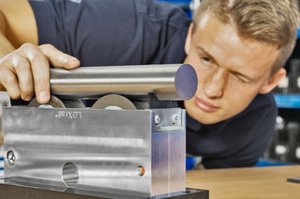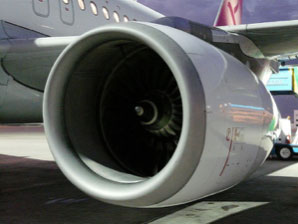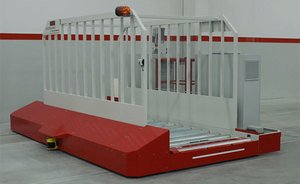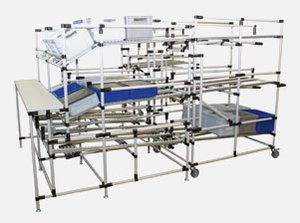![[Translate to Englisch:] Lean Manufacturing](/fileadmin/_processed_/9/e/csm_lean-manufacturing_29c77278f5.jpg)
A holistic concept to optimize production, lean manufacturing includes a variety of coordinated methods and measures that can significantly boost efficiency. Small and medium-sized companies are particularly likely to benefit substantially from switching to lean manufacturing. To this end, LOSYCO offers production logistics system solutions and tried-and-tested practical support based on academic expertise.
Lean manufacturing covers not only the production process, but also various other factors that are essential for a culture of efficient, streamlined manufacturing. These include an optimized setup of all work stations with proper equipment, targeted measures to avoid activities that do not deliver added value, on-site material provisioning, warehouse management, supply chain organization, and quality assurance.

"Multiple measures can only be applied in a coordinated fashion that achieves maximum joint impact if every one of them meets the specific internal requirements of the company," says Manuel Granz, Managing Director at the intralogistics specialist, LOSYCO. "This is why we first gather information on location and map out the manufacturing facilities and processes. We work out a target concept together with plant managers and proceed to analyze the individual production steps along with material and tool requirements. Then we develop solutions to align all production logistics – notably, to align them in a way that facilitates executing all essential activities in the most ergonomic, timely, and cost-efficient way possible." In order to incorporate the latest cutting-edge know-how in production logistics, LOSYCO cooperates with research entities such as the Institute for Economic and Technological Corporate Management (IWT Institute e.V.), which is associated with Hochschule Ostwestfalen-Lippe, a leading higher education institution in the region.
Starting in the Japanese automotive industry, lean manufacturing techniques have come to be established all over the world in recent decades. They have fundamentally changed the character of industrial production. Through decentralization and synchronization of structures within an organization, competencies and responsibilities can be assigned to that organization's primary production teams – including, for example, the responsibility for quality assurance as well as maintenance. Formerly functionally separate departments like product development and process planning, engineering, and manufacturing now directly work together, with the aim to be able to immediately identify and eliminate any barriers to production. Instead of working at a set capacity to achieve arbitrary production goals, all production logistics follow the pull principle and are entirely governed by customer demand, which minimizes overcapacity and avoids building up costly stockpiles. By also integrating suppliers and external manufacturers, this approach strives to cover demand just in time. In recent years, the all-encompassing trend to go digital is the driving force behind more and more advanced lean manufacturing techniques. As comprehensive information is collected and all production-relevant data are evaluated, all processes in the value chain are now to be controlled and made transparent for largely self-organizing production in real time.

One very effective approach to streamline production structures is a revamping of production logistics. Making an investment into a cycle-based production line is likely to pay off particularly quickly in industries such as machine building, tool construction, and systems engineering, where labor-intensive work in manufacturing islands or boxes is still common practice. However, many machine and tool manufacturers are wary of restructuring their manufacturing processes. They are concerned that high investment and operating costs may not be offset by the productivity gains that are to be expected. Widely used transport solutions on the factory floor, e.g. indoor cranes, air cushion systems, or conventional rail transport constructions, are usually costly to procure, expensive to install, require a lot of maintenance, and consume a lot of energy. "That is why we have developed an economical alternative with the easy-to-install LOXrail® that is also simple as well as very safe to operate. On our trolleys for this special rail design, even parts that weigh a ton or more can be manually moved, without an auxiliary drive, from one assembly station to the next. The rails are flush with the floor, and switches and crossings enable very flexible individual layouts as needed on location. This is why LOXrail® is also highly suitable for retrofitting existing factories," explains Clark.

A manufacturing cycle can be established where individual production steps are precisely differentiated, and each of them is assigned to a specific work station. Every unfinished product then goes through these stations in a set sequence until its completion. This means that there is no longer a need to keep all sorts of special tools and materials readily available at every single assembly station. Instead, the manufacturing sequence proceeds in a continuous flow. This ensures a consistent workload for employees while also achieving shorter overall production times, because production steps are then seamlessly following each other and idle times that would incur costs are eliminated. Implementing this level of transparency regarding manufacturing and tool and material requirements leads to lower expenses for production,operation and storage. Stock-keeping and buffer stages are shortened, resulting in faster turnaround times with increased throughput.
At the same time, one-piece flow production facilitates the implementation of further efficiency-enhancing measures to minimize unproductive activities. Avoiding "muda" – which commonly translates to "waste" – is crucial to the lean manufacturing approach. "Muda includes all activities that make no direct or indirect contribution to added value, but on the contrary cause unnecessary and avoidable costs," explains Clark. "Muda typically occurs as a consequence of excessive stock-piling of materials, delays in material flow, waiting times and other idle times, overproduction, rejects and late efforts to mend defective goods, and extra walking distances. Every single extra meter an employee has to walk during the manufacturing process, e.g. to fetch a tool or obtain some materials, adds an estimated 3 cents to the operating expenses. All things considered, wasteful practices can diminish the pure value added in some areas to as little as 5%."

In a Kanban environment, material supply is organized in a way that enables a full-scale implementation of the pull principle across all delivery and production steps. The entire manufacturing process is driven by incoming orders and is therefore, in a sense, "pulled" from the customer side. Triggered by the last production step, a self-organized process chain emerges. Resources, materials and precursor products enter the manufacturing process precisely when they must be integrated. Instead of a central warehouse where all required parts and resources are continually stocked, material provision is decentralized according to the Kanban principle. Every station is a so-called "sink" that keeps parts on hand. If spare stock runs below a defined minimum, an order card or electronic Kanban is sent to the upstream production unit or relevant supply unit ("source"). That source then turns out the requested number of pieces and delivers them with new Kanban information to the requesting station.
Stations-based logistics extends all the way to include the supply chains, since it is possible to determine precisely how many components and materials are needed at a specific station at a specific time. This further contributes to value creation, because stocks and storage space can be greatly reduced and most required supplies can be provided just-in-time. Capital that used to be sunk in stockpiles is freed up, which improves the liquidity of the company. One-piece flow with regular cycle times enables faster on-time completion of customer orders. Since production cycle timing and production volumes can be mapped out with great long-term predictability, the company is always aware which order volumes are to be handled at any given time, which helps ensure high reliability and on-time delivery.
In order to optimize production logistics, LOSYCO and the IWT Institute offer a free efficiency check including industry-specific benchmarking for small and medium-sized enterprises. "This three-to four-hour examination is divided into two steps: first, we conduct a joint inspection of the production facilities with the user and analyze essential criteria of the existing working environment. This includes assessments of workplace equipment and lighting, the layout of the production area, material flow, intra-logistics, production control, and warehouse technology. Then we explore options and appropriate methods to optimize production in an interview and based on the user's self-assessment," explains Clark. "At this point, it is evident which concrete measures would yield the greatest efficiency gains, and how they can be implemented in an economically sound way to gain a lasting competitive edge."